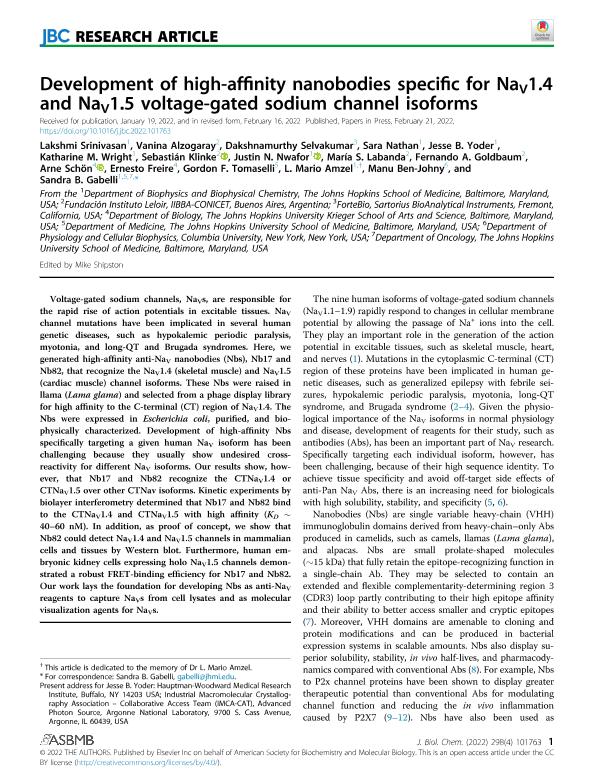Mostrar el registro sencillo del ítem
dc.contributor.author
Srinivasan, Lakshmi
dc.contributor.author
Alzogaray, Vanina Andrea

dc.contributor.author
Selvakumar, Dakshnamurthy
dc.contributor.author
Nathan, Sara
dc.contributor.author
Yoder, Jesse B.
dc.contributor.author
Wright, Katharine M.
dc.contributor.author
Klinke, Sebastian

dc.contributor.author
Nwafor, Justin N.
dc.contributor.author
Labanda, María Soledad

dc.contributor.author
Goldbaum, Fernando Alberto

dc.contributor.author
Schön, Arne
dc.contributor.author
Freire, Ernesto
dc.contributor.author
Tomaselli, Gordon F.
dc.contributor.author
Amzel, León Mario

dc.contributor.author
Ben-Johny, Manu
dc.contributor.author
Gabelli, Sandra

dc.date.available
2023-06-16T18:49:10Z
dc.date.issued
2022-04
dc.identifier.citation
Srinivasan, Lakshmi; Alzogaray, Vanina Andrea; Selvakumar, Dakshnamurthy; Nathan, Sara; Yoder, Jesse B.; et al.; Development of high-affinity nanobodies specific for NaV1.4 and NaV1.5 voltage-gated sodium channel isoforms; American Society for Biochemistry and Molecular Biology; Journal of Biological Chemistry (online); 298; 4; 4-2022; 1-16
dc.identifier.issn
0021-9258
dc.identifier.uri
http://hdl.handle.net/11336/200892
dc.description.abstract
Voltage-gated sodium channels, NaVs, are responsible for the rapid rise of action potentials in excitable tissues. NaV channel mutations have been implicated in several human genetic diseases, such as hypokalemic periodic paralysis, myotonia, and long-QT and Brugada syndromes. Here, we generated high-affinity anti-NaV nanobodies (Nbs), Nb17 and Nb82, that recognize the NaV1.4 (skeletal muscle) and NaV1.5 (cardiac muscle) channel isoforms. These Nbs were raised in llama (Lama glama) and selected from a phage display library for high affinity to the C-terminal (CT) region of NaV1.4. The Nbs were expressed in Escherichia coli, purified, and bio-physically characterized. Development of high-affinity Nbs specifically targeting a given human NaV isoform has been challenging because they usually show undesired cross-reactivity for different NaV isoforms. Our results show, however, that Nb17 and Nb82 recognize the CTNaV1.4 or CTNaV1.5 over other CTNav isoforms. Kinetic experiments by biolayer interferometry determined that Nb17 and Nb82 bind to the CTNaV1.4 and CTNaV1.5 with high affinity (KD ~ 40-60 nM). In addition, as proof of concept, we show that Nb82 could detect NaV1.4 and NaV1.5 channels in mammalian cells and tissues by Western blot. Furthermore, human embryonic kidney cells expressing holo NaV1.5 channels demonstrated a robust FRET-binding efficiency for Nb17 and Nb82. Our work lays the foundation for developing Nbs as anti-NaV reagents to capture NaVs from cell lysates and as molecular visualization agents for NaVs.
dc.format
application/pdf
dc.language.iso
eng
dc.publisher
American Society for Biochemistry and Molecular Biology

dc.rights
info:eu-repo/semantics/openAccess
dc.rights.uri
https://creativecommons.org/licenses/by/2.5/ar/
dc.subject
VOLTAGE-GATED SODIUM CHANNELS
dc.subject
NAVS
dc.subject
HIGH-AFFINITY ANTI-NAV NANOBODIES
dc.subject
ANTI-NAV REAGENTS
dc.subject.classification
Bioquímica y Biología Molecular

dc.subject.classification
Ciencias Biológicas

dc.subject.classification
CIENCIAS NATURALES Y EXACTAS

dc.title
Development of high-affinity nanobodies specific for NaV1.4 and NaV1.5 voltage-gated sodium channel isoforms
dc.type
info:eu-repo/semantics/article
dc.type
info:ar-repo/semantics/artículo
dc.type
info:eu-repo/semantics/publishedVersion
dc.date.updated
2023-06-12T17:33:09Z
dc.journal.volume
298
dc.journal.number
4
dc.journal.pagination
1-16
dc.journal.pais
Estados Unidos

dc.journal.ciudad
Bethesda
dc.description.fil
Fil: Srinivasan, Lakshmi. University Johns Hopkins; Estados Unidos
dc.description.fil
Fil: Alzogaray, Vanina Andrea. Consejo Nacional de Investigaciones Científicas y Técnicas. Oficina de Coordinación Administrativa Parque Centenario. Instituto de Investigaciones Bioquímicas de Buenos Aires. Fundación Instituto Leloir. Instituto de Investigaciones Bioquímicas de Buenos Aires; Argentina
dc.description.fil
Fil: Selvakumar, Dakshnamurthy. Fortébio; Estados Unidos
dc.description.fil
Fil: Nathan, Sara. University Johns Hopkins; Estados Unidos
dc.description.fil
Fil: Yoder, Jesse B.. University Johns Hopkins; Estados Unidos
dc.description.fil
Fil: Wright, Katharine M.. University Johns Hopkins; Estados Unidos
dc.description.fil
Fil: Klinke, Sebastian. Consejo Nacional de Investigaciones Científicas y Técnicas. Oficina de Coordinación Administrativa Parque Centenario. Instituto de Investigaciones Bioquímicas de Buenos Aires. Fundación Instituto Leloir. Instituto de Investigaciones Bioquímicas de Buenos Aires; Argentina
dc.description.fil
Fil: Nwafor, Justin N.. University Johns Hopkins; Estados Unidos
dc.description.fil
Fil: Labanda, María Soledad. Consejo Nacional de Investigaciones Científicas y Técnicas. Oficina de Coordinación Administrativa Parque Centenario. Instituto de Investigaciones Bioquímicas de Buenos Aires. Fundación Instituto Leloir. Instituto de Investigaciones Bioquímicas de Buenos Aires; Argentina
dc.description.fil
Fil: Goldbaum, Fernando Alberto. Consejo Nacional de Investigaciones Científicas y Técnicas. Oficina de Coordinación Administrativa Parque Centenario. Instituto de Investigaciones Bioquímicas de Buenos Aires. Fundación Instituto Leloir. Instituto de Investigaciones Bioquímicas de Buenos Aires; Argentina
dc.description.fil
Fil: Schön, Arne. University Johns Hopkins; Estados Unidos
dc.description.fil
Fil: Freire, Ernesto. University Johns Hopkins; Estados Unidos
dc.description.fil
Fil: Tomaselli, Gordon F.. University Johns Hopkins; Estados Unidos
dc.description.fil
Fil: Amzel, León Mario. University Johns Hopkins; Estados Unidos
dc.description.fil
Fil: Ben-Johny, Manu. Columbia University; Estados Unidos
dc.description.fil
Fil: Gabelli, Sandra. University Johns Hopkins; Estados Unidos
dc.journal.title
Journal of Biological Chemistry (online)

dc.relation.alternativeid
info:eu-repo/semantics/altIdentifier/url/https://www.sciencedirect.com/science/article/pii/S0021925822002034
dc.relation.alternativeid
info:eu-repo/semantics/altIdentifier/doi/https://doi.org/10.1016/j.jbc.2022.101763
Archivos asociados
